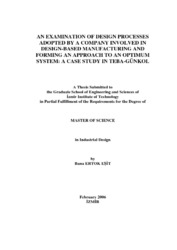Please use this identifier to cite or link to this item:
https://hdl.handle.net/11147/3252Full metadata record
| DC Field | Value | Language |
|---|---|---|
| dc.contributor.advisor | Özcan, A. Can | en |
| dc.contributor.author | Ertok Eşit, Banu | - |
| dc.date.accessioned | 2014-07-22T13:51:11Z | - |
| dc.date.available | 2014-07-22T13:51:11Z | - |
| dc.date.issued | 2006 | en |
| dc.identifier.uri | http://hdl.handle.net/11147/3252 | - |
| dc.description | Thesis (Master)--Izmir Institute of Technology, Industrial Design, Izmir, 2006 | en |
| dc.description | Includes bibliographical references (leaves: 63-69) | en |
| dc.description | Text in English; Abstract:Turkish and English | en |
| dc.description | x, 71 leaves | en |
| dc.description.abstract | Today, a company's competitive advantage is directly related to its capacity to develop new products and global competitive pressure has motivated many companies to change to a more rapid form of product development with an emphasis on team and cross functional working. Concurrent Engineering (CE), or Concurrent Design, is a widely recognized approach to improving product introduction which attracts increasing attention of companies throughout the world. In the context of today.s manufacturing industry, design is essentially a social and collaborative process, thereby imposing cross-functional integration on companies. CE can be defined as a development philosophy that could improve design and produce better process quality via both integration and coordination. The CE approach enables synchronization of structural design and manufacturing processes, thus reduces product development time, and decreases costs by eliminating many of the trial-error steps. This research focuses on CE by using a case-study approach carried out in a Turkish company which has been selected as a representative sample of the companies involved in design-based manufacturing in Turkey. In this thesis, the traditional methods used by the company are extensively analysed and a Concurrent Engineering system for the optimum design and manufacturing of new products is proposed. The objective of this study is to provide further insight into the organizational aspect for success in Concurrent Engineering practices in design-based manufacturing. | en |
| dc.language.iso | en | en_US |
| dc.publisher | Izmir Institute of Technology | en |
| dc.rights | info:eu-repo/semantics/openAccess | en_US |
| dc.subject.lcc | TS176 .E34 2006 | en |
| dc.subject.lcsh | Concurrent engineering | en |
| dc.title | An examination of design processes adopted by a company involved in design-based manufacturing and forming an approach to an optimum system: A case study in Teba-Günkol | en_US |
| dc.type | Master Thesis | en_US |
| dc.institutionauthor | Ertok Eşit, Banu | - |
| dc.department | Thesis (Master)--İzmir Institute of Technology, Industrial Design | en_US |
| dc.relation.publicationcategory | Tez | en_US |
| item.languageiso639-1 | en | - |
| item.fulltext | With Fulltext | - |
| item.openairecristype | http://purl.org/coar/resource_type/c_18cf | - |
| item.openairetype | Master Thesis | - |
| item.grantfulltext | open | - |
| item.cerifentitytype | Publications | - |
| Appears in Collections: | Master Degree / Yüksek Lisans Tezleri | |
Files in This Item:
| File | Description | Size | Format | |
|---|---|---|---|---|
| T000353.pdf | MasterThesis | 7.44 MB | Adobe PDF |  View/Open |
CORE Recommender
Page view(s)
84
checked on Jul 22, 2024
Download(s)
40
checked on Jul 22, 2024
Google ScholarTM
Check
Items in GCRIS Repository are protected by copyright, with all rights reserved, unless otherwise indicated.